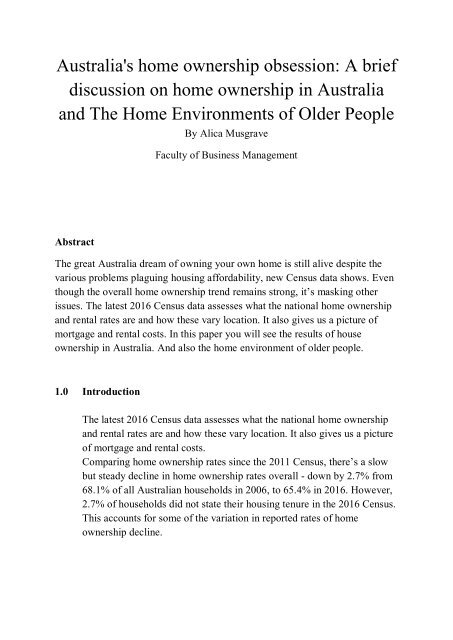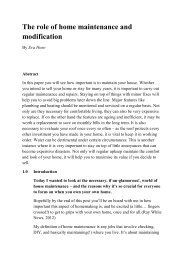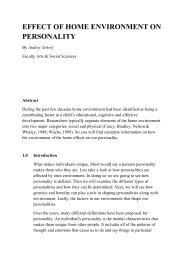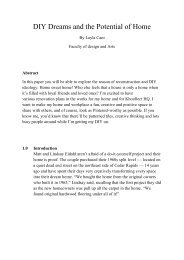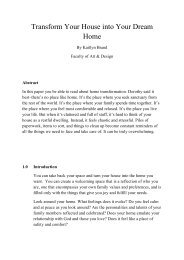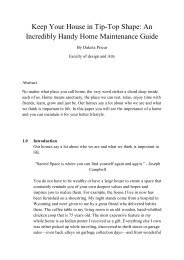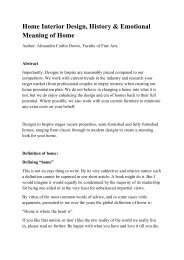Australia home ownership obsession
You also want an ePaper? Increase the reach of your titles
YUMPU automatically turns print PDFs into web optimized ePapers that Google loves.
<strong>Australia</strong>'s <strong>home</strong> <strong>ownership</strong> <strong>obsession</strong>: A brief<br />
discussion on <strong>home</strong> <strong>ownership</strong> in <strong>Australia</strong><br />
and The Home Environments of Older People<br />
By Alica Musgrave<br />
Faculty of Business Management<br />
Abstract<br />
The great <strong>Australia</strong> dream of owning your own <strong>home</strong> is still alive despite the<br />
various problems plaguing housing affordability, new Census data shows. Even<br />
though the overall <strong>home</strong> <strong>ownership</strong> trend remains strong, it’s masking other<br />
issues. The latest 2016 Census data assesses what the national <strong>home</strong> <strong>ownership</strong><br />
and rental rates are and how these vary location. It also gives us a picture of<br />
mortgage and rental costs. In this paper you will see the results of house<br />
<strong>ownership</strong> in <strong>Australia</strong>. And also the <strong>home</strong> environment of older people.<br />
1.0 Introduction<br />
The latest 2016 Census data assesses what the national <strong>home</strong> <strong>ownership</strong><br />
and rental rates are and how these vary location. It also gives us a picture<br />
of mortgage and rental costs.<br />
Comparing <strong>home</strong> <strong>ownership</strong> rates since the 2011 Census, there’s a slow<br />
but steady decline in <strong>home</strong> <strong>ownership</strong> rates overall - down by 2.7% from<br />
68.1% of all <strong>Australia</strong>n households in 2006, to 65.4% in 2016. However,<br />
2.7% of households did not state their housing tenure in the 2016 Census.<br />
This accounts for some of the variation in reported rates of <strong>home</strong><br />
<strong>ownership</strong> decline.
This contraction is nowhere of the scale of equivalent falls in <strong>home</strong><br />
<strong>ownership</strong> in the US and UK and New Zealand over the same period.<br />
Figure 1<br />
What’s more interesting than the overall trend, is the greater decline in<br />
outright <strong>home</strong> <strong>ownership</strong>, involving no mortgage debt, from 32.1% to<br />
31.0% between 2011 and 2016. There’s also a lesser decline in <strong>home</strong><br />
owners who are purchasing with mortgage debt 34.9% in 2011 compared<br />
with 34.5% in 2016.<br />
Figure 2
The opportunity households now have to borrow against their mortgage<br />
loans for spending undoubtedly accounts for some of this change. Also<br />
contributing to this is <strong>home</strong> purchasers are less likely to reach retirement<br />
age with no remaining mortgage debt, in the same numbers as previous<br />
eras.<br />
Another aspect of housing affordability is masked by these numbers - the<br />
wide variation in being able to purchase a <strong>home</strong> according to age and<br />
income. Recent evidence indicates would-be-<strong>home</strong>-owners try various means<br />
including very high mortgage debt and moving to outer urban locations<br />
away from employment and into smaller dwellings, to be able to buy a<br />
house. Some even delay having kids.<br />
Census figures show that for people wanting to purchase a <strong>home</strong>, a<br />
change in state or city location may be an option. According to the data<br />
Darwin was the most expensive city to buy in, whereas Hobart was the<br />
cheapest for <strong>home</strong> purchasers.<br />
Figure 3<br />
For households across the income spectrum, 7.2% of purchasers are<br />
paying more than 30% of their income on mortgage costs, the data shows.<br />
This figure is likely to be far higher among the lowest income (40% of<br />
households) for whom such costs place them in housing poverty.<br />
Given the national <strong>obsession</strong> with investment in private rental, it’s no<br />
surprise that the proportion of all <strong>Australia</strong>n households now renting has<br />
also increased. Census 2016 results show the private rental sector grew in
size, from 21.0% in 2006, to 22.8% in 2011 and to 24.9% in<br />
2016.(theconversation, 2017)<br />
2.0 Capital cities with the highest proportion of renters in <strong>Australia</strong><br />
On average <strong>Australia</strong>ns are paying $427 per week in rent with rents rising<br />
1.1 per cent in the first quarter of this year.<br />
Sydney-siders paid the highest median rent ($582 per week), while<br />
Adelaide residents paid the least ($374) out of all the capital cities.<br />
But it was Hobart's landlords who scored the best deal, with rents<br />
increased by 5 per cent in the last quarter, and 11.7 per cent in the last<br />
twelve months.<br />
Property owners in the Tasmanian capital are also currently enjoying the<br />
second highest rental yield in the country (5 per cent) — second only to<br />
Darwin (5.8 per cent), according to key findings from data analytics firm<br />
CoreLogic in its Quarterly Rental Review.<br />
2.1 Slow start to the year<br />
Figure 4<br />
Rental rates, on a national basis, lifted by 1.5 per cent in the first<br />
three months of 2017. In comparison, they rose by a slower 1.1 per<br />
cent between January and March, this year.
"The first quarter of each year is typically the strongest for rental<br />
growth, so this is a step down," CoreLogic's head of research<br />
Cameron Kusher said.<br />
Figure 5<br />
"Investors remain most active in NSW and Victoria, and have been<br />
targeting capital growth rather than rental return."(Abc.net.au,<br />
2018)<br />
3.0 The Changing Dream<br />
Over the past few years, housing affordability has regularly dominated<br />
the headlines, initially as rising house prices pushed access to <strong>home</strong><br />
<strong>ownership</strong> out of reach and, subsequently, as increases in interest rates<br />
created repayment problems for those who had taken on significant<br />
amounts of housing debt. Most media attention is focused on the<br />
affordability problems faced by aspiring first <strong>home</strong> buyers, who are seen<br />
to be giving up the Great <strong>Australia</strong>n Dream. The data in Figure 1 suggest<br />
there is considerable evidence to indicate that they are giving up that<br />
dream. Figure 1 shows a steady decline in age-specific <strong>home</strong> <strong>ownership</strong><br />
rates for younger households from the mid- to late 1970s. Between 1976<br />
and 2001, <strong>home</strong> <strong>ownership</strong> rates for those in the 25–29 year old age<br />
group declined by 11 percentage points (from 54 per cent to 43 per cent),<br />
by 10 percentage points (from 67 per cent to 57 per cent) for those in the<br />
30–34 year old age group and by 6 percentage points (from 72 per cent to<br />
66 per cent) for those in the 35–39 year old age group.
Figure 6<br />
This paper examines the implications for young adults of the changing<br />
patterns of investment in housing over several generations. It provides a<br />
brief snapshot of three distinct phases in the evolution of <strong>home</strong><br />
<strong>ownership</strong>: as an aspiration of households in the 1950s and 1960s, as a<br />
driver of inequality for their baby boomer children in the 1970s and<br />
1980s, and as a fading dream of their grandchildren from the 1990s to the<br />
present. Whilst it might be dangerous to use the past to predict the future,<br />
it is equally dangerous to ignore the lessons of the past in determining<br />
what might happen in the future. Badcock and Beer (2000) describe those<br />
who entered <strong>home</strong> <strong>ownership</strong> in the 1950s and 1960s as the Safe and<br />
Sound generation and those who entered in the 1970s and 1980s as the<br />
pampered generation. As will be argued below, it is the baby boomer<br />
generation that profited most from <strong>home</strong> <strong>ownership</strong>. The question of<br />
whether their Generation X children1 – described by Hugh Mackay as the<br />
Options generation (Mackay, 1997) – can or will enter <strong>home</strong> <strong>ownership</strong><br />
has yet to be answered.<br />
The three sections of this chapter are based on the experiences of these<br />
three generations. The chapter begins with the rise of <strong>home</strong> <strong>ownership</strong> in<br />
the period immediately following WWII, and ends with the rise in rental<br />
investment that dominated the most recent house price boom. It describes<br />
how the changing economic and social climate changed the nature of the<br />
Great <strong>Australia</strong>n Dream for each of these generations, and suggests that<br />
this has contributed to its downfall. Chapters two and three highlight<br />
implications of the changes that have occurred and suggest some changes
that might be needed for the <strong>home</strong> <strong>ownership</strong> dream of the past to be reimagined<br />
for the future.(Yates, 2007)<br />
4.0 Roadmap to Buying Your First Home<br />
Almost two years ago, I became a <strong>home</strong>owner.<br />
I had no idea what I was getting myself into when Kate and I decided we<br />
were ready to buy a <strong>home</strong>. I naively thought there wouldn’t be much to it.<br />
Visit some open houses, talk to the bank, sign some papers, and boom,<br />
I’d have a piece of the American Dream.<br />
Boy, was I wrong.<br />
Buying a <strong>home</strong> is a complicated, multi-step process. Down the road we<br />
plan to devote entire posts to many of the steps along the way. Today,<br />
however, we’ve set out to provide you with the big picture of what to<br />
expect when buying your first <strong>home</strong>. It’s basically the roadmap I wish I<br />
had when I was neck-deep in the process.<br />
Figure 7<br />
It should be noted that each state (and country) has vastly different laws<br />
regarding real estate. This is a rough idea of the process, but especially<br />
when it gets to working with realtors, making offers, and the closing<br />
process, things can look quite different. Research you own state’s or<br />
country’s processes.
4.1 Determine If Buying Is Right for You<br />
Before you start attending open houses and munching on free<br />
cucumber sandwiches, you need to figure out if buying a <strong>home</strong> is<br />
even the right move for you. It’s a big decision that comes with<br />
huge time and financial commitments. When figuring out whether<br />
buying makes sense right now in your life, take into account your<br />
finances as well as your future plans. For help in thinking through<br />
the pros and cons, check out our guide on whether you should buy<br />
a <strong>home</strong> or rent.<br />
4.2 Get Your Financial House in Order<br />
Once you decide to move forward, it’s time to get your financial<br />
house in order to prepare for buying a physical one. Here are some<br />
things to consider doing:<br />
Start saving for a down payment. If you haven’t already,<br />
start saving for a down payment on your mortgage. Most<br />
traditional mortgage brokers require that you have at least a<br />
20% down payment to qualify for a mortgage. Even if you’re<br />
able to secure a Federal Housing Administration loan (FHA<br />
loan – for first-time <strong>home</strong> buyers only), you’ll still need to<br />
have at least a 3.5% down payment (some loans will require<br />
a 5% down payment. For a $250,000 mortgage, that means<br />
you’ll need at least $8,500 in the bank, and that doesn’t<br />
include all the other costs that go along with buying a <strong>home</strong>,<br />
as we’ll find out later. That’s nothing to sniff at. Start saving<br />
today.<br />
Get a copy of your credit report and credit scores. When<br />
a bank decides whether to loan you money for a <strong>home</strong>, one<br />
of the things it’s going to look at is your history as a<br />
borrower. They want to know that they can trust you to pay<br />
back this massive amount of money they’re about to give<br />
you. To determine whether you’re creditworthy, the bank or<br />
mortgage broker is going to look at your credit report and<br />
credit score. Before the banks pull your report and score, it’s<br />
a good idea to take a look at them yourself to ensure that<br />
there aren’t any errors that could hurt your chances for
securing a mortgage. Errors to look for include accounts that<br />
don’t belong to you, wrong addresses, incorrect payment<br />
status, and remedied delinquencies not reported as such. If<br />
you find any errors, take action to correct them as quickly as<br />
possible as they can sometimes take a long time (and be nigh<br />
near impossible) to fix.<br />
If you don’t have any errors on your credit report, but your<br />
credit score isn’t that hot, start taking steps to improve it like<br />
paying your bills on time and reducing the amount of debt<br />
you owe.<br />
Gather financial documents. When you apply for a <strong>home</strong><br />
mortgage, your financial life is going to be put under a<br />
microscope. You’ll have to provide enough documentation<br />
to prove that you’re financially capable of paying back a<br />
large loan. I wish I had done this step earlier in the process<br />
and not waited until I was actually applying for a loan.<br />
Despite having most of my financial documents digitized, it<br />
was still a chore corralling them together. Below are the<br />
documents you’ll likely need when applying for a mortgage:<br />
• W2 statements (or 1099 income statements) for the<br />
last two years<br />
• Federal tax returns for the last two years<br />
• Bank statements for the last few months<br />
• Recent pay stubs and proof of other income<br />
• Proof of investment income<br />
Get pre-qualified for a loan. Call up your bank and ask to<br />
get pre-qualified for a loan. When you get pre-qualified for a<br />
loan a bank takes a cursory look at your financial status and<br />
tells you whether you’d be able to qualify, and if so, roughly<br />
how much of a mortgage you can get. This can give you a<br />
rough idea of how much house you can afford when you’re<br />
out looking. Getting pre-qualified is quick and easy. You can<br />
usually do it over the phone or even online. One important
thing to understand is that getting pre-qualified for a loan<br />
doesn’t guarantee that you’ll actually get a mortgage for the<br />
amount the bank pre-qualifies you for. That number can<br />
change as the mortgage broker takes a deeper look at<br />
your finances. Again, it’s a rough estimate.(Brett & Kate<br />
McKay, 2013)<br />
5.0 The Home Environments of Older People in <strong>Australia</strong><br />
Mick Jagger won’t ever need to be concerned about having somewhere to<br />
live, but older people have worried about where they will spend their<br />
final years since long before the Rolling Stones sang to a generation’s<br />
insecurities in 1969. Many wish to stay in their <strong>home</strong>s, but current policy<br />
doesn’t support age-friendly housing. It also makes it difficult for ageing<br />
people to manage their finances.<br />
Figure 8<br />
The population of people aged 65 and over in <strong>Australia</strong> is projected to<br />
grow from 3.7 million to 8.7 million by 2056. Cities, towns and housing<br />
need to be designed to help people stay at <strong>home</strong> as they age. Financial<br />
policy should be updated to enable them to better manage their assets.
6.0 What is stopping people ‘ageing in place’?<br />
Gwen’s deck of dominoes could not be reconfigured because of the<br />
housing, tax and financial barriers imposed by the same governments that<br />
are trying to implement ―ageing in place‖.<br />
Ageing in place isn’t just about ageing at <strong>home</strong>. It’s about keeping older<br />
people connected to their neighbourhood and community as part of a<br />
broader framework of ―active ageing‖, with the aim of improving their<br />
quality of life and giving them more control over their circumstances.<br />
Since the World Health Organization (WHO) released its Active<br />
Ageingpolicy framework in 2002, federal governments have endorsed<br />
this approach. The 2013 Living Longer Living Better reforms and last<br />
year’s Legislated Review of Aged Care promote emotional and mental<br />
preparation for old age, which is important for active ageing.<br />
However, many aspects of policy in <strong>Australia</strong> undermine successful<br />
ageing in place.(Mick Jagger, 2015)<br />
7.0 The Social Home: Roles, Relationships and Networks<br />
The meaning of <strong>home</strong> as a place to strengthen and secure important<br />
relationships was a theme that emerged strongly from this study. For<br />
some participants, social relationships were of more importance and high<br />
value than other aspects of <strong>home</strong> such as comfort, ease of access, and<br />
functionality. Relationships that extend outside of the <strong>home</strong> were as<br />
highly valued as those within the <strong>home</strong>. Existing social networks<br />
contributed strongly to the essence of what <strong>home</strong> meant and to the<br />
individuals’ sense of identity. (BondcleaninginPerth, 2015)<br />
This was particularly evident for one participant who reported great<br />
difficulty in managing the steps and bathroom of her current <strong>home</strong>.<br />
Because minor modifications had given her little functional improvement,<br />
she was offered new fully accessible accommodation less than 1<br />
kilometer away from her current <strong>home</strong>. One of the main reasons she gave<br />
for declining this move was that she would lose her role as an informal<br />
―bus stop guardian.‖
For many years, she monitored children getting on and off the bus<br />
because the school bus stopped outside her house, with many of them<br />
waiting in her yard in the morning and afternoon under her protective<br />
eye. She valued this role higher than the need for ease of access to her<br />
house or bathroom.<br />
―I enjoy it here. The fact . . . [that] I have about 8 or 10 kids come of a<br />
morning now that school’s started. They wait here; if it’s raining, they<br />
wait on the veranda and otherwise they’ll wait in the yard and go out<br />
when the bus comes for the children . . . and I like to be able to make sure<br />
they’re on the bus safe. Some of them get off here in the afternoon and<br />
the rest will get off in front of their place or another stop further down.<br />
But they all like to get on here. . . . By them being here the bus comes<br />
along up the road here, they walk across to catch it and I know they’re<br />
safe. . . . It makes you feel you’re doing something even though I’m not<br />
really doing anything . . . to most of the neighborhood children I’m<br />
―Nanna.‖ It doesn’t matter whether they are related or not. I’m Nanna.<br />
Even the 18- and 19-year-olds . . . still refer to me as Nanna. I’ve got a<br />
very large family! (Betty, aged 66 years)‖<br />
8.0 The Physical Home—Space and Comfort<br />
Related to the importance of the social experience of <strong>home</strong>, many<br />
participants emphasized having physical space. For many of the people<br />
interviewed, space was an important factor in their enjoyment of <strong>home</strong><br />
because they identified the need to have space for family to come and<br />
stay. Space was also identified as important for keeping pets. Maintaining<br />
a comfortable physical environment, particularly by managing the<br />
discomfort of heat and having pleasing aesthetics, was also an issue for<br />
many participants.<br />
9.0 The Future Home—Out in a Wooden Box<br />
The desire of participants to remain in their current <strong>home</strong> and not have to<br />
move was strongly evidenced in the findings. This study supports the<br />
often expressed assumption that most people wish to remain in their<br />
<strong>home</strong> as they age, preferably until they die or at least are not able to<br />
manage for themselves any longer. As for this place, the only way they’ll<br />
get me out of here is to take me out in a wooden box. (Jean, aged 66<br />
years)
10.0 Impact of Home Modifications on the Meaning of Home<br />
Restoring Home as a Place of Security Safety and Comfort In examining<br />
the impact of modifying the physical environment of the <strong>home</strong>, the<br />
findings show that reducing the demand of the environment through<br />
modifications strengthens the personal <strong>home</strong> as a place of security, safety,<br />
comfort, and control rather than one of risk, dependence, struggle, or<br />
even imprisonment. Participants of the study spoke of how modifications<br />
have increased independence, safety, and comfort in performing daily<br />
tasks. It’s great, just great. They put grab rails all around. . . . [It’s] safer .<br />
. . [and] it’s more convenient too. It’s much more comfortable. (Colin,<br />
aged 77 years)<br />
‣ Independence, Identity, and Impact on Carers<br />
Participants reported that modifications increased their<br />
independence, allowing for the maintenance of habitual personal<br />
routines. Independence afforded by <strong>home</strong> modifications also<br />
resulted in greater feelings of control and self-efficacy. Some<br />
participants no longer had to rely on others (community services or<br />
spouses, in particular) to assist in personal care or to provide meals.<br />
In theses cases, modifications reinforce the control an individual<br />
has over routines, daily activities, and others’ access to them<br />
(privacy).<br />
Figure 9
Home, as a place of personal control, mastery, and self-efficacy, is<br />
reinforced. I’ve got more confidence and I don’t have to depend on<br />
somebody to be here in case I fall. It’s made me totally<br />
independent now. (Jean, aged 66 years) In reducing reliance on<br />
carers, who are often spouses or family members, there was often a<br />
reported alteration in the dynamic of the relationship. One<br />
participant reported feeling less ―cosseted‖ by his partner and<br />
others reported that their spouse was less tied to the house and<br />
more able to engage in preferred activities by no longer having to<br />
be present to assist them. To be able to get around like that without<br />
having to be cosseted . . . it’s very important. Luckily I’ve got a<br />
younger wife who [is] very good to me. She looks after me<br />
anyway, but it’s much better if I can do some things for myself. It’s<br />
better for my self-esteem and also for her benefit as well. She’s got<br />
a bad back as well and so it doesn’t help matters. (Colin, aged 77<br />
years) One carer reported a dramatic change in the quality of life<br />
for both her father (for whom she cares) and herself as a result of<br />
having a water lift installed. [It’s been] excellent! We’ve been dirty<br />
stop outs! We’ve been out nearly every day. It’s improved the<br />
quality of life. . . . Oh yeah we were just pulling our hair out—so<br />
locked up! I know what it’s like to be in prison but now we’ve just<br />
been going everywhere. Oh yeah, we’re very very happy. We’ve<br />
never been the happiest as when we saw it. . . . We thought ―Oh,<br />
fantastic.‖ (Rhonda, daughter and carer for Ray, aged 72<br />
years).(Tanner, Tilse, & De Jonge, 2008)<br />
11.0 Growing at Home<br />
Planning ahead is hard because you never know how your needs might<br />
change. The first step is to think about the kinds of help you might want<br />
in the near future. Maybe you live alone, so there is no one living in your<br />
<strong>home</strong> who is available to help you. Maybe you don't need help right now,<br />
but you live with a spouse or family member who does. Everyone has a<br />
different situation.<br />
One way to begin planning is to look at any illnesses,<br />
like diabetes or emphysema, that you or your spouse might have. Talk with<br />
your doctor about how these health problems could make it hard for<br />
someone to get around or take care of him- or herself in the future. If
you're a caregiver for an older adult, learn how you can get them the<br />
support they need to stay in their own <strong>home</strong>.(growingold, 2015)<br />
12.0 Conclusion<br />
Memories, too, are cued by the physical environment. When you visit a<br />
place you used to live, these cues can cause you to revert back to the<br />
person you were when you lived there. The rest of the time, different<br />
places are kept largely separated in our minds. The more connections our<br />
brain makes to something, the more likely our everyday thoughts are to<br />
lead us there. But connections made in one place can be isolated from<br />
those made in another, so we may not think as often about things that<br />
happened for the few months we lived someplace else. Looking back,<br />
many of my <strong>home</strong>s feel more like places borrowed than places possessed,<br />
and while I sometimes sift through mental souvenirs of my time there, in<br />
the scope of a lifetime, I was only a tourist.<br />
I can't possibly live everywhere I once labeled <strong>home</strong>, but I can frame<br />
these places on my walls. My decorations can serve as a reminder of the<br />
more adventurous person I was in New York, the more carefree person I<br />
was in Paris, and the more ambitious person I was in Michigan. I can't be<br />
connected with my <strong>home</strong> in the intense way South Asians are in Sax's<br />
book, but neither do I presume my personality to be context-free. No one<br />
is ever free from their social or physical environment. And whether or not<br />
we are always aware of it, a <strong>home</strong> is a <strong>home</strong> because it blurs the line<br />
between the self and the surroundings, and challenges the line we try to<br />
draw between who we are and where we are.
References<br />
Abc.net.au. (2018). Regional rents are rising 61pc faster than capital cities.<br />
Abc.Net.Au. Retrieved from http://www.abc.net.au/news/2018-04-<br />
17/sydney-renters-pay-most-darwin-hobart-best-rental-yields/9666750<br />
Brett & Kate McKay. (2013). Roadmap to Buying Your First Home | The Art of<br />
Manliness. Retrieved May 26, 2018, from<br />
https://www.artofmanliness.com/articles/how-to-buy-first-<strong>home</strong>/<br />
growingold. (2015). Aging in Place: Growing Old at Home. Retrieved May 26,<br />
2018, from https://www.nia.nih.gov/health/aging-place-growing-old-<strong>home</strong><br />
Mick Jagger. (2015). For <strong>Australia</strong>ns to have the choice of growing old at <strong>home</strong>,<br />
here is what needs to change. Retrieved May 26, 2018, from<br />
https://theconversation.com/for-australians-to-have-the-choice-of-growingold-at-<strong>home</strong>-here-is-what-needs-to-change-91488<br />
BondcleaninginPerth. (2015). What is the Best method to Clean Oven Windows<br />
and Grills? - Bond Cleaning Perth. Retrieved May 26, 2018, from<br />
https://www.bondcleaninginperth.com.au/best-method-clean-ovenwindows-grills/<br />
Tanner, B., Tilse, C., & De Jonge, D. (2008). Restoring and Sustaining Home:<br />
The Impact of Home Modifications on the Meaning of Home for Older<br />
People. Journal of Housing for the Elderly, 22(3).<br />
https://doi.org/10.1080/02763890802232048
theconversation. (2017). Home <strong>ownership</strong> remains strong in <strong>Australia</strong> but it<br />
masks other problems: Census data. Retrieved May 26, 2018, from<br />
http://theconversation.com/<strong>home</strong>-<strong>ownership</strong>-remains-strong-in-australiabut-it-masks-other-problems-census-data-80068<br />
Yates, J. (2007). Affordability and access to <strong>home</strong> <strong>ownership</strong>: past, present and<br />
future? National Research Venture 3: Housing affordability for lower<br />
income <strong>Australia</strong>ns. Retrieved from<br />
https://www.ahuri.edu.au/__data/assets/pdf_file/0017/2690/NRV3_Researc<br />
h_Paper_10.pdf


